Search Results
Call for artists: Sell your work at Let's Glow! BART Anime Festival on September 6

The call for artists is now closed.
BART is seeking artists to sell their work at BART’s upcoming anime festival, Let’s Glow! The festival will be held at Warm Springs/South Fremont Station on Saturday, September 6, from 4:30pm to 8pm.
We are looking for 15 to 20 artists of all skills, styles, and mediums to table at this first-of-its-kind celebration of BART, art, and anime. Tabling is free!
Artists must apply to sell at the event, and BART’s anime team will select the roster of vendors from the applicant pool. While art need not feature transit, strong preference will be given to work that does. We encourage artists to make BART-themed artwork to sell, but we ask that the fan art does not contain the BART logo to distinguish it from official communications. Art must be appropriate for an all-ages audience.
Some examples of the type of work we’re looking for:
- A print, postcard, or bookmark depicting a BART station in the artist’s preferred style
- T-shirts, tote bags, keychains featuring a train operator character
- A download code to an album of train departure melodies
Surprise us! We are looking for originality and creativity.
Submit your work at https://bart-anime.notion.site/216b53326cb280dd8549e02d7d3d615e
Deadline: Sunday, August 17, 2025, 11:59pm
More on Let’s Glow!
This is a first-of-its-kind celebration of BART, art, and anime that will feature food and boba stands, lantern decoration, live DJ group AniClover, wotagei lessons from SanFlare, itasha decorated cars, and more. We will release additional details soon. This is a free, un-ticketed event.
Let us know you're coming - RSVP here: https://bartletsglow.eventbrite.com
Read about the BART Anime Project at bart.gov/anime
From swimming holes to Star Wars drone shows: Take BART on the town this weekend

Friday, Aug. 18, 2023 – It was yet another high ridership weekend on Saturday, Aug. 5, and Sunday, Aug. 6, as Outside Lands Music Festival, the Pistahan Parade and Festival, and other exciting events unfurled across the Bay Area. Saturday and Sunday saw 101,100 and 79,300 exits respectively meaning more than 180,000 people rode BART last weekend (that’s roughly the populations of Berkeley, Benicia, and El Cerrito combined).
Looking for something to do this weekend? Keep reading and visit our BARTable website. We publish a weekly event roundup, BARTable This Weekend, which highlights happenings around the region as well as contests and sweepstakes.
This weekend, BART will be running extra trains for these big events: the Star Wars Drone Show following the A’s game on Saturday, and the Zach Bryan concert at the Oakland Arena on Monday.
Fri/Sat/Sun: Athletics vs. Orioles at the Oakland Coliseum (plus a Star Wars Drone Show!)
The Oakland Athletics face the Baltimore Orioles on Friday, Saturday, and Sunday – and each game offers a special themed promotion. For the Star Wars Drone Show on Saturday night, BART will be running extra trains to accommodate the anticipated crowds.
Here’s the lowdown on this weekend’s games: Friday, Aug. 18 (6:40pm start time) is Jerry Garcia Night, a tribute to the legendary Bay Area musician. Saturday, Aug. 19 (6:07pm start time) is the Star Wars Drone Show (with a special Mark Kotsay Mandalorian Bobblehead on offer). And Sunday, Aug. 20 (1:07pm start time), will see a “t-shirt hoodie” giveaway for early arriving fans, presented by Cal State East Bay.
It’s also First Responders Weekend at the Coliseum, with special prices, tailgates, jerseys, and more for first responders. (Promo info here.)
Use our guide to taking BART to the game here.
Sat/Sun: Take BART to the FOG India Day Parade and Fair in Fremont
On Saturday, Aug. 19, and Sunday, Aug. 20, the City of Fremont will host the largest India Day parade on the West Coast with more than 130 booths and 50,000 attendees. To get there, take BART to Fremont Station and travel about 0.6 miles to the event site – 39439 Paseo Padre Parkway, Fremont.
The fair takes over the parkway on Saturday and Sunday from 10am to 6pm, and the parade runs Sunday from 11am to 1pm. Bollywood superstar Mahima Chaudhry will serve as the grand marshal. Keep your eyes out for the BART booth, where BART directors, staff, and officers will be on hand with free swag and information about the system and our programs. More info here.
Mon: Singer-Songwriter Zach Bryan at the Oakland Arena on Monday
Singer-songwriter Zach Bryan touches down in Oakland this Monday, Aug. 21, for a stop on his Burn, Burn, Burn tour at the Oakland Arena (take BART to Coliseum Station) with Trampled by Turtles and Levi Turner. The show starts at 8pm and doors open at 6:30pm.
BART will be running extra trains Monday night to take concertgoers home.
Explore BARTable Pools, Coves, and Lagoons
Did you know you can take BART to swim? Cool off this weekend by visiting a BARTable swimming hole. We rounded them up (with directions) in this article.
Win Tickets to the “Hippest Trip – The Soul Train Musical” World Premiere
Win two tickets for you and your guest to the world premiere of "Hippest Trip -The Soul Train Musical" at A.C.T.'s Toni Rembe Theater in San Francisco on Saturday, Sept. 2 at 8pm. Five lucky winners will take the prize! Learn more about the Broadway-bound musical and enter the sweepstakes by clicking here.
Weekend Read: The Couple Who Hosted a BART Wedding at Fairyland
On May 27, 2023, Armin Samii and Marylee Williams married in a BART-themed wedding at Oakland’s Fairyland.
The couple, who met on BART, said, “We wanted a venue that was easily accessible to our guests, and accessibility to us looks like BART. BART was where we had our first taste of not being bound by a car.”
Read more about the wedding and see the colorful photos on bart.gov/news.
Happy Riding this Weekend!
We hope you enjoy your weekend adventures aboard our trains.
Stay in touch by signing up for the BARTable This Week newsletter on the BARTable website – your one-stop shop for all things accessible by BART. You can also keep up with BARTable on Facebook and Instagram.
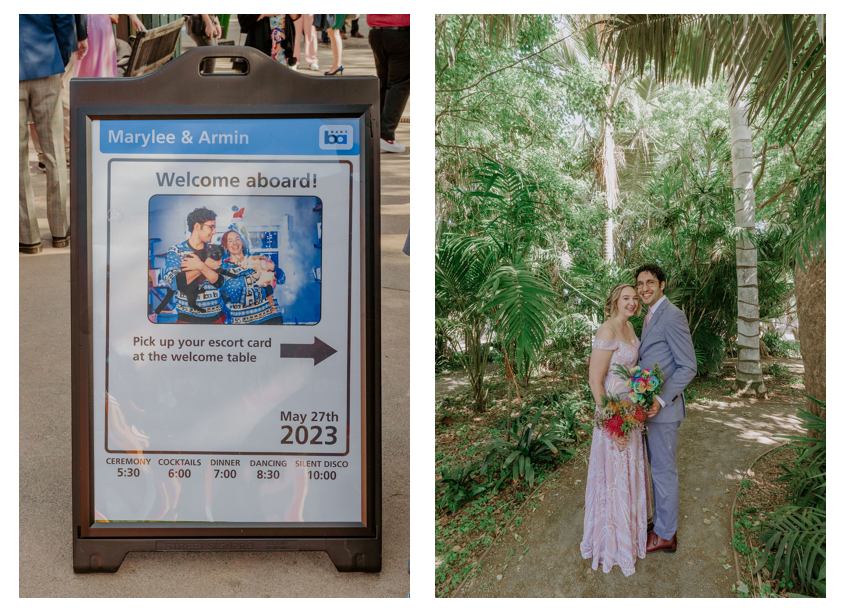
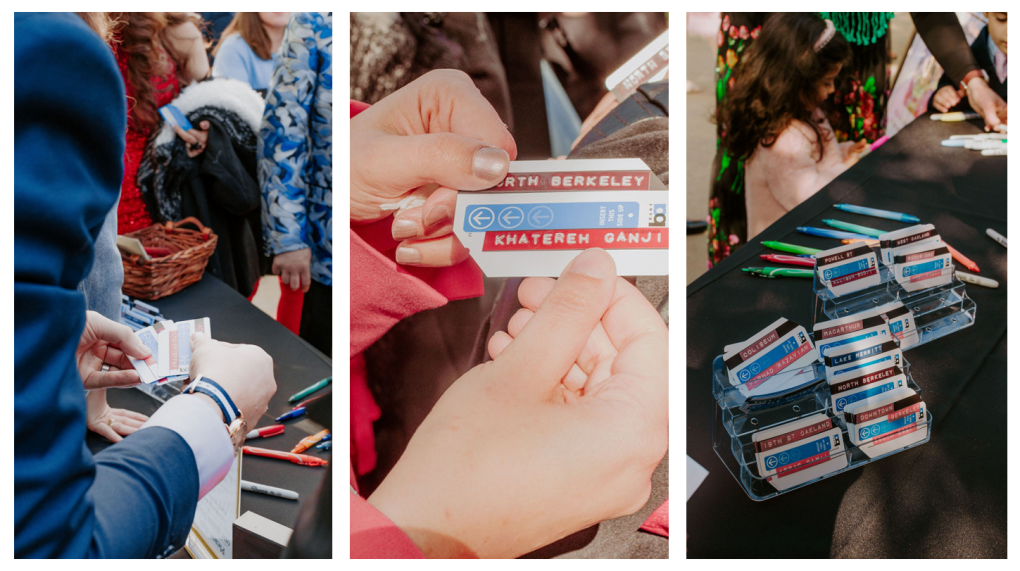

BART releases Draft FY08 10-year Operating Plan and 25-year Capital Improvement Program
BART's Fiscal Year 2008 Draft Short Range Transit Plan and Capital Improvement Program (SRTP/CIP) is now available. Prepared in compliance with the Metropolitan Transportation Commission's (MTC) guidelines and principles, the SRTP/CIP is required by the Federal Transit Administration and the MTC as a
BART ridership continues to grow; September ridership increased by 10% over previous year
BART ridership continues to grow, with notable gains on weekends as Saturday ridership this September was nearly 20% higher compared to the previous year. More than 5 million trips were taken on BART in September, exceeding expected trips by 5%. Overall, ridership saw a nearly 10% increase over the same month last year.
The increase in ridership on the weekends, especially Saturdays, demonstrates that people are taking BART for purposes beyond getting to the office. For example, the Japan v. Mexico soccer match on Saturday, September 6, drew 23,000 trips to Coliseum Station, the third-highest ridership day for the station since the pandemic. In fact, ridership for the match was nearly a third higher than the average Saturday ridership for A’s games in 2019.
Ridership growth is only part of the solution to BART’s significant financial crisis. To close BART’s $375 million deficit with only fare revenue, current ridership levels would need to more than double; BART’s latest budget forecast estimates a 4% ridership increase in 2026.
BART’s slow and steady ridership recovery correlates with work from home rates in the region. While individual riders are returning to BART, they’re taking fewer trips, likely due to remote and hybrid work schedules.
September ridership highlights at a glance:
- September ridership was 10% higher compared to previous year (5,047,000 total trips).
- Saturdays in September of this year grew 20% over a year ago.
- Highest ridership day: Wednesday, September 10 (220,073).
- BayPass, the region’s all-in-one transit pass, ridership more than doubled over last September, driven primarily by UC Berkeley students voting to expand the program to the entire study body of ~45,000. The BayPass referendum was approved with 90% "yes" votes. Ridership growth at Downtown Berkeley Station has outpaced systemwide growth since the start of the Fall 2025 semester.
- Tap and Ride usage accounted for approx. 8% of total trips on weekdays and 12% on weekends. SFO Station accounts for nearly 30% of all Tap and Ride trips. Tap and Ride gives riders the ability to pay adult fares at BART fare gates using physical contactless credit or debit cards or mobile payment methods, such as Apple Pay and Google Pay.
- Usage of Clipper START, the region’s low-income discount fare program, is at an all-time high and accounted for 3.4% of total trips in September. BART has more Clipper START rides than any other agency.
Additional ridership information is publicly available and posted monthly at bart.gov/about/reports/ridership.
Sound Tracks, BART’s free summer concert series, returns; next performance is September 4

Sound Tracks, BART’s free summer concert series, returns for three shows in August and September. The outdoor series, presented by the BART Art Program, is part of BART’s rider engagement strategy to activate stations, show appreciation for riders and neighbors, and support local artists – all for the love of music.
Performances will be held in the unpaid areas of stations, and attendees are encouraged to take BART. Dance bands have been so successful at past events that for this series, we’re bringing out musicians that know how to get a crowd on their feet.
Said Jennifer Easton, BART Art Program Manager: “The BART Art Program centers supporting local artists and delivering arts and cultural programming to enhance rider and community experience. Sound Tracks encourages riders to take a minute to celebrate with station neighbors, support local businesses, and enables BART to show our appreciation for all the people who ride the system and to those that make the station areas vibrant.”
Up next on the schedule:
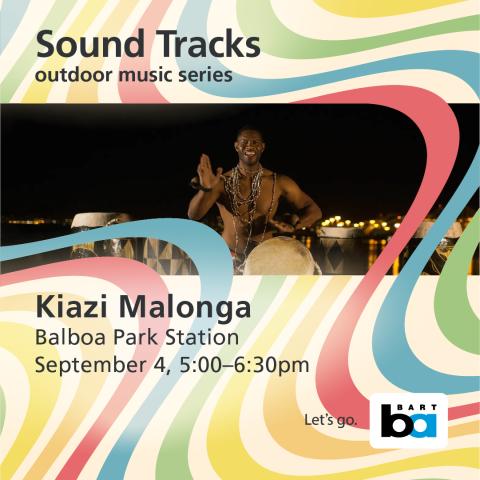
Wednesday, Sept. 4, 5 pm to 630pm, Balboa Park: Kiazi Malonga (Congolese drummer performing with full percussion band)
Previously:
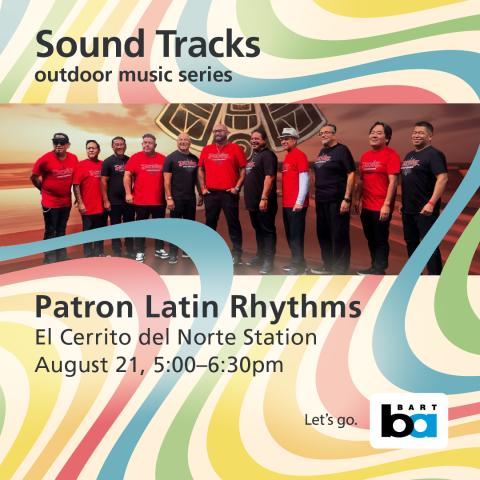
Wednesday, August 21, 5pm to 630pm, El Cerrito del Norte Station: Patron Latin Rhythms (Latin jazz, Latin rock, Mambo). Special reading by winners of the BART Lines Teen Poetry Contest.

Wednesday, Aug. 28, 5pm to 630pm, Pleasant Hill/Contra Costa Centre: Chris Trinidad y Con Todo featuring Mestiza (Cuban Timba, Puerto Rican Bomba, and Afro-Caribbean genres mixed with Latin jazz, soul, and R&B)
Join us with your BART holiday sweater on 12/10/23 for SweaterFest '23

It's the most BARTable time of the year!
Celebrate our third year of the immensely popular BART holiday sweater at SweaterFest '23! Wear your BART holiday sweater from any year and join BART staff and fellow riders for a group photo at Rockridge Station on Sunday, December 10 from 2-3:30pm.
For riders who did not pre-order the 2023 BART holiday staff but would like to purchase one, staff will be selling the 2023 holiday sweater at SweaterFest '23. We will have contests, prizes, other BART merch for sale, music, and more to make it a true holiday event! Winners of our SweaterFest '23 Raffle can win exclusive BART prizes. (Raffle contestants must be present to win prizes)
Extra 2023 BART holiday sweaters will go on sale at railgoods.com after Thanksgiving.
For pre-orders who selected the pick-up option, your holiday sweater is available for pick-up at BART HQ, 2150 Webster Street in Oakland (walkable distance from 19th St Oakland Station) on weekdays from November 22 until December 7. The hours for pick-up are between 8:30am until 4pm. November 23 and November 24 will not be open due to Thanksgiving.
Starting December 11, pre-order pick-ups will be moved to the Customer Services Center at Lake Merritt Station on the concourse level.
Don’t be left out in the cold…grab your sweater and join us for a family-friendly, holiday-celebrating SweaterFest ’23!
We plan to introduce our new stamp rally passport at SweaterFest. If you attend the Meet the Anime Mascots event at Powell Street, be sure to bring your stamp from that event and we will add it to our passport.
BART PD earns highest level of accreditation from expert law enforcement panel
At its national conference the Commission on Accreditation for Law Enforcement Agencies (CALEA) reaffirmed the BART Police Department continues to meet the standard of the group’s Advanced Law Enforcement Accreditation. BART PD – which is in the process of filling 29 sworn officer vacancies this fiscal year - was already among the fewer than 6% of law enforcement agencies across the country that has earned accreditation from CALEA. This advanced accreditation places BART PD in an even smaller pool of departments and acknowledges the department’s commitment to following industry best practices, building community trust, and engaging in more than decade long commitment to reform.
“BART PD is working around the clock to ensure every rider feels safe from the moment they step into a station to the moment they arrive at their destination,” said interim BART PD Chief Kevin Franklin. “Our accreditation from CALEA wouldn’t be possible without the hard work of everyone in the department. Certification from CALEA is the gold standard for law enforcement. It shows the confidence of outside experts in the work being done by our department to continue improving, while ensuring we are keeping BART riders and workers safe across the Bay Area.”
BART PD first earned CALEA accreditation in 2019 and had to demonstrate at the conference the department has been meeting or exceeding CALEA’s standards. “We recognize that accreditation is a process, not a destination,” continued Franklin. “We are committed to continuing with the hard work to measure up to CALEA’s high standards as well as the demands of our riders who expect us to do everything we can to keep them safe every time they ride.”
BART PD earned its original CALEA accreditation as part of its more than decade long commitment to police reforms. The National Organization of Black Law Enforcement Executives (NOBLE) recommended in its final report issued in 2010 that BPD seek this accreditation. NOBLE conducted a top-to-bottom review of BPD after the tragic shooting death of Oscar Grant in 2009.
BART PD must prove compliance with nearly 400 standards annually as part of the Advanced Law Enforcement Accreditation Program. The comprehensive process included an on-site review by CALEA which focused on facility inspections, staff interviews, and gathering public input.
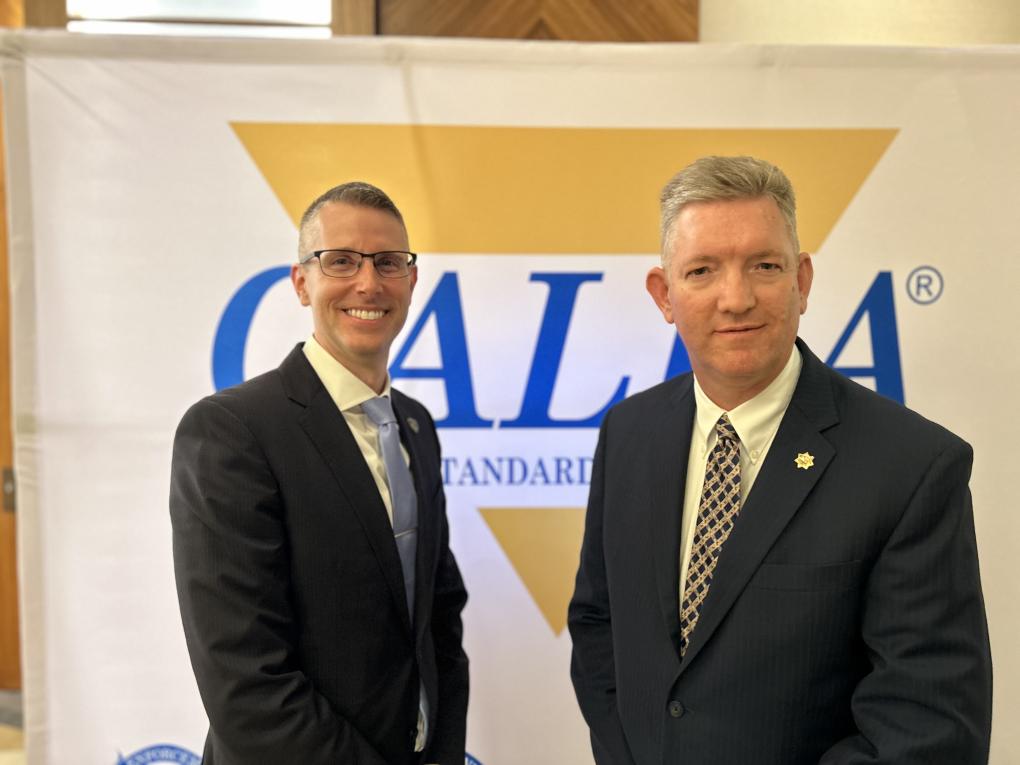
BART Police honor outstanding officers and civilians at tenth annual BPD Awards Ceremony
People celebrate at the tenth annual BPD Awards Ceremony on Dec. 14, 2022. On Wednesday, Dec. 14, the BART Police Department hosted its tenth annual end-of-year awards ceremony, honoring the individuals who served exceptionally over the past year. “Thank you for your efforts and dedication towards the pursuit
BART Board of Directors elects Bevan Dufty president and Mark Foley vice president
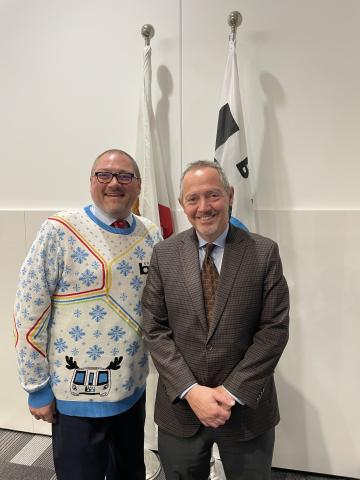
BART Director Bevan Dufty said he was “extremely hopeful” about the upcoming year following a vote today that elected him president of the BART Board. Dufty said he will work hard to support and collaborate with the BART team to solve problems and to anticipate the challenges ahead.
“I am so proud of the work this agency does to support the Bay Area community,” President Dufty said. “I look forward to working hand in hand with the rest of the Board in 2024.”
President Dufty was first elected to the BART Board of Directors in November 2016 and was re-elected in 2020. He represents District 9, which includes portions of San Francisco. Dufty served as president in 2019.
Director Mark Foley, who was elected vice president, said 2024 will be an exciting, but challenging year.
“There are a lot of great things happening at the agency we should celebrate,” Vice President Foley said. “People in the Bay Area love BART and what we do. We mean so much to people and provide a crucial lifeline for people traveling to school, to doctors’ appointments, and to work.”
Vice President Foley was first elected to the BART Board in November 2018 and was re-elected in 2022. Vice President Foley represents District 2, which includes Antioch, Brentwood, Concord (partial), and other cities and unincorporated communities in Contra Costa County.
Vice President Foley served as board president in 2021 and vice president in 2020 and 2022.
Watch Janice Li’s outgoing remarks as Board President, during which she highlights BART’s top accomplishments of 2023.